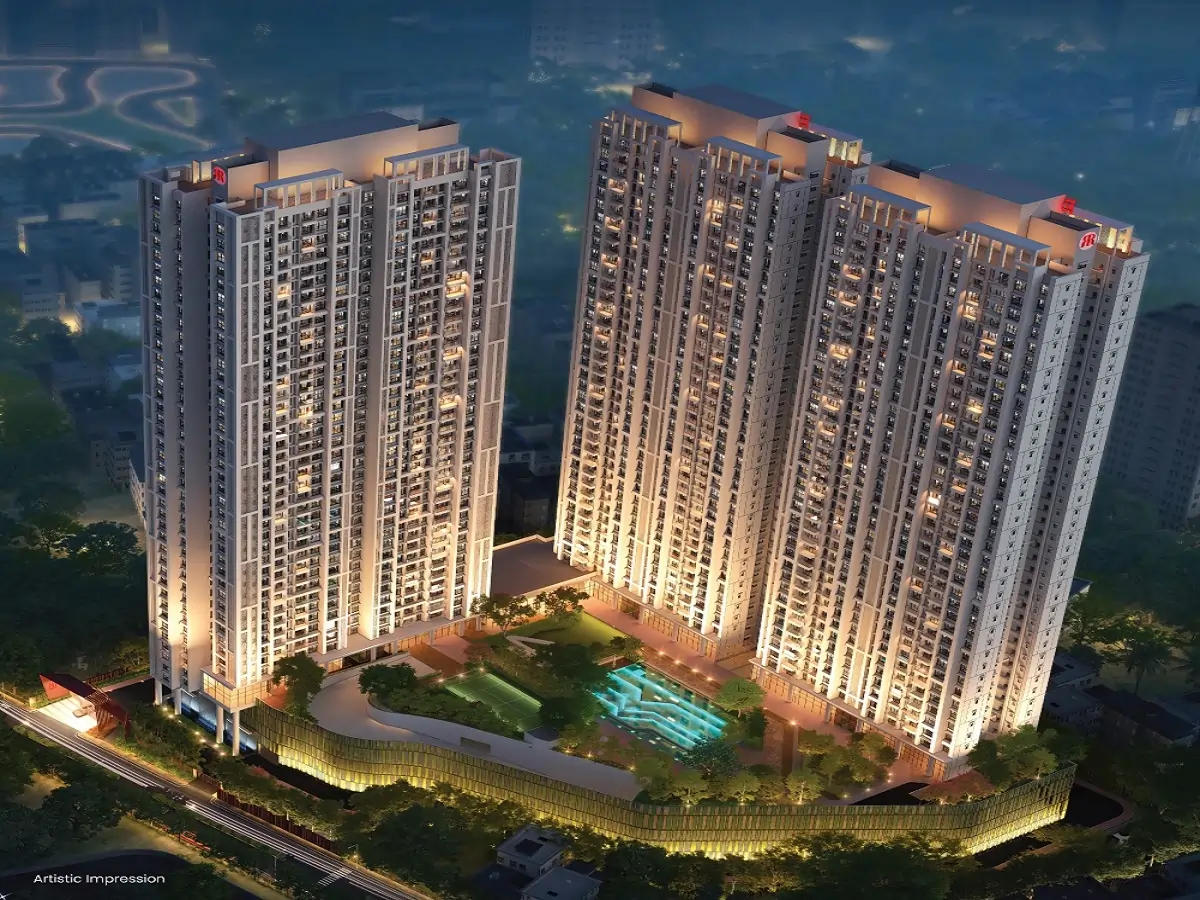Upstox Originals
Is housing for all slipping out of reach?

7 min read | Updated on October 28, 2025, 16:24 IST
SUMMARY
Housing sales across India’s top seven cities dropped nearly 9% year-on-year in H1 2025 — but luxury housing, priced above ₹1 crore, surged with a 14% jump in sales value. Behind the glossy towers and glossy headlines lies a deeper story — of middle-class homebuyers being priced out, developers shifting focus upward, and India’s dream of “Housing for All” facing a quiet squeeze.

Since its inception, Raymond Realty has completed two housing projects, while six projects are under construction. | Image: Company website
India’s real estate market in 2025 is running on two parallel tracks. On one track, ultra-luxury projects — penthouses in Gurugram, sky villas in South Mumbai, and branded residences in Bengaluru — are selling out before the paint dries. On the other, mid-income and affordable housing — the ₹40 lakh to ₹1 crore range that once drove India’s housing boom — is slowing down sharply.
According to ANAROCK Research, housing sales across the top seven cities fell ~9% YoY in the first half of 2025, marking the first slowdown in three years. Yet, the luxury and premium category saw a 14% rise in total sales value — proof that India’s wealthy are still betting on real estate, even as the middle class hesitates.
The Middle-class crunch: When homeownership is slipping
The middle class once anchored India’s real estate story. Between 2014 and 2021, low interest rates, stable prices, and government schemes like PM Awas Yojana (PMAY-Urban) helped millions of first-time buyers enter the market.
But 2025 looks different.
A mix of rising prices, high EMIs, and stagnant incomes has quietly edged the middle class out.
-
The average home loan size in major metros has risen to ₹38 lakh, up 22% from 2021.
-
Yet, household income growth over the same period is up only 10–12%, according to RBI data.
Result: The EMI-to-income ratio — a measure of housing affordability — has climbed to 55–60% in 2025, up from around 40% in 2019.
That means for every ₹100 a household earns, ₹55–₹60 now goes toward home loan repayments.
No wonder, then, that mid-tier buyers are hesitating. Many are choosing to rent longer, or move further from city centers to find something affordable.
“For many middle-income families, homeownership has moved from being an aspiration to an anxiety,” says Anuj Puri, Chairman of ANAROCK Group.
The numbers tell the story
Let’s look at what’s happening on the ground:
| Segment | Average Price (2025) | YoY Change in Sales Volume | Share of Total Sales (2023 → 2025) |
|---|---|---|---|
| Affordable (<₹40 lakh) | ₹35 lakh | -13% | 24% → 19% |
| Mid-income (₹40 lakh–₹1 crore) | ₹70 lakh | -8% | 40% → 39% |
| Premium/Luxury (₹1 crore–₹4 crore) | ₹2.1 crore | +9% | 27% → 30% |
| Ultra-Luxury (>₹4 crore) | ₹6.8 crore | +14% | 9% → 12% |
Source: ANAROCK, Knight Frank India, H1 2025
The data shows that affordable and mid-income homes — which together made up nearly two-thirds of India’s housing market in 2023 — now contribute less than 60%. Meanwhile, luxury and ultra-luxury projects have expanded their market share to nearly 42%.
Why luxury Is winning
Luxury real estate is thriving for reasons far beyond aesthetics.
Rising wealth at the top
According to Hurun India’s Wealth Report 2025, India added 38,000 new millionaires in the past year. Many are first-generation entrepreneurs, tech professionals, and global executives looking to park money in tangible assets amid volatile equity and crypto markets.
Developers follow the margin
With construction costs rising 15–18% since 2022 and land prices escalating, developers find better margins in luxury. While affordable housing offers margins of 10–12%, luxury can deliver 25–30% or more. So, builders are rebranding or pivoting. Projects once priced at ₹80 lakh are now being relaunched above ₹1 crore with “premium finishes.”
Brand power and foreign tie-ups
From DLF’s Camellias in Gurugram to Prestige Group’s Four Seasons Residences in Bengaluru, branded luxury homes are seeing robust demand from NRIs and domestic HNIs.
DLF reported its highest-ever quarterly sales in FY25, driven entirely by its luxury and super-luxury portfolio.
Luxury as a safe haven
Real estate remains one of India’s preferred inflation hedges. With deposit rates stagnant and equity markets volatile, high-net-worth investors are diversifying into high-value property as a “store of wealth.”
Why the mid-tier is struggling
While the rich are doubling down, the middle class is running out of options.
Policy fatigue
The government’s Credit Linked Subsidy Scheme (CLSS) under PMAY expired in March 2024, with no immediate replacement. This has left a vacuum in mid-income support mechanisms.
Supply-side slowdown
Developers are reluctant to launch affordable or mid-tier projects due to squeezed margins and regulatory costs. Between 2023 and 2025, new affordable housing launches fell by 18%, according to Knight Frank’s India Real Estate Report 2025.
Urban land inflation
Land values in key micro-markets like Mumbai, Pune, and Bengaluru have surged 30–40% in the past three years, pushing even mid-income homes into the “luxury” bracket by default.
Regional snapshot: A tale of seven cities
| City | YoY Change in Total Sales | Luxury Segment Growth | Key Trend |
|---|---|---|---|
| Mumbai | -6% | +18% | Ultra-luxury towers & redevelopment boom |
| Delhi-NCR | -4% | +16% | Gurugram dominates; DLF & M3M projects hot |
| Bengaluru | -8% | +12% | Tech-driven demand, rising NRIs interest |
| Pune | -11% | +9% | Mid-tier slowdown; affordable stock falling |
| Hyderabad | -10% | +14% | High-ticket launches near Gachibowli |
| Chennai | -13% | +8% | Modest launches; focus shifting to villas |
| Kolkata | -9% | +7% | Weak absorption, limited new launches |
Source: Knight Frank, ANAROCK H1 2025)
The Investment lens: What about REITs and developers?
The market’s polarisation is also reshaping how investors look at real estate.
REITs (Real Estate Investment Trusts)
Residential REITs, still nascent in India, could find opportunities in rental yield from luxury projects or co-living models in mid-income suburbs. However, subdued mid-tier sales mean limited cash-flow stability, something REITs rely on for steady payouts.
Developers
Publicly listed developers like DLF, Godrej Properties, and Prestige Estates have already reoriented toward premium housing. Godrej Properties’ FY25 investor call revealed that 72% of its new launches were in the premium/luxury bracket, up from 48% two years ago.
Smaller regional developers, lacking deep pockets or brand value, are feeling the heat — struggling with funding, slower sales, and unsold inventory in mid-income categories.
The Policy Side: What can fix the mid-segment?
-
Revised credit-linked subsidy scheme Industry experts are urging the government to relaunch CLSS with higher eligibility thresholds, raising the ₹18 lakh annual income cap to ₹25 lakh.
-
Interest subvention for first-time buyers Subsidising 2–3% interest on first-time home loans up to ₹50 lakh could reignite demand among the middle class.
-
Tax breaks for developers Offering GST relief or stamp duty waivers on mid-income projects could help make this segment viable again.
-
Incentivised rentals and REIT integration With ownership getting costlier, a structured rental housing policy — tied to REIT participation, could formalise the mid-income rental market.
The psychology of 2025 buyers: Wait, Bargain, or Leap?
For homebuyers, the 2025 market poses a dilemma.
-
Waiters: Those betting on a correction might be waiting longer than expected. Developers, cushioned by luxury sales, aren’t slashing prices.
-
Bargainers: Mid-tier buyers can negotiate on under-construction projects or outskirts, especially in Pune, Chennai, and Hyderabad.
-
Leapers: Affluent buyers are jumping in, preferring luxury assets now to hedge against inflation and currency depreciation.
According to PropTiger, only 14% of new launches in 2025 were priced below ₹50 lakh — compared to 28% in 2022. This shift signals that for the middle class, waiting could mean getting priced out further.
The bottom line
India’s housing market isn’t collapsing — it’s recalibrating. Luxury is rising because it’s financially rational for developers and aspirationally magnetic for buyers.
But this tilt is widening a structural divide.
As one analyst put it: “India is building more square feet than ever before — just not for the people who need them most.”
If the next phase of real estate growth has to be inclusive, policy and private capital must meet somewhere in the middle, between the glass towers of Gurugram and the unbought flats on the city’s edge.
Until then, housing in 2025 will remain a story of two Indias — one climbing higher, and one priced out of the view.
By signing up you agree to Upstox’s Terms & Conditions
About The Author
Next Story
